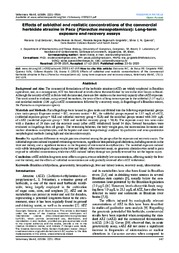Effects of sublethal and realistic concentrations of the commercial herbicide atrazine in Pacu (Piaractus mesopotamicus): long-term exposure and recovery assays.
Effects of sublethal and realistic concentrations of the commercial herbicide atrazine in Pacu (Piaractus mesopotamicus): long-term exposure and recovery assays.
Author(s): DELCORSO, M. C.; PAIVA, P. P. de; GRIGOLETO, M. R. P.; QUEIROZ, S. C. do N. de; COLLARES-BUZATO, C. B.; ARANA, S.
Summary: Abstract: Background and Aim: The commercial formulations of the herbicide atrazine (cATZ) are widely employed in Brazilian agriculture, and, as a consequence, ATZ has been found at levels above that established by law in the river basins in Brazil. Although the toxicity of ATZ in fish is well documented, there are few studies on the recovery capacity after cATZ exposure. This work aimed to evaluate, using several biomarkers, the toxic effects of long-term exposure to the sublethal (3.57 mg/L) and nonlethal realistic (3.00 ?g/L) cATZ concentrations followed by a recovery assay, in fingerlings of a Brazilian teleost, the Piaractus mesopotamicus (pacu). Materials and Methods: Pacu fingerlings were housed in glass tanks and divided into the following experimental groups (two tanks/group): Exposure control = EC, recovery control = RC, the sublethal groups exposed to 3.57 mg/L of cATZ, (sublethal exposure group = SLE and sublethal recovery group = SLR) and the nonlethal groups treated with 3.00 μg/L of cATZ (nonlethal exposure group = NLE and nonlethal recovery group = NLR). The exposure assay was semi-static with a duration of 30 days and the recovery assay (after cATZ withdrawal) lasted 14 days. Several biomarkers were evaluated in fingerlings from all groups: The swimming behavior, the body weight gain, the micronucleus formation and nuclear alterations in erythrocytes, and the hepatic and renal histopathology analyzed by qualitative and semi-quantitative morphological methods (using light and electron microscopy). Results: No significant difference in weight gain was observed among the groups after the exposure and recovery assays. The sublethal exposure induced impaired swimming movements, significant histopathological alterations, including necrosis in the liver and kidney, and a significant increase in the frequency of micronuclei in erythrocytes. The nonlethal exposure induced only subtle histopathological changes in the liver and kidney. After recovery assay, no genotoxic alteration was noted in pacu exposed to sublethal concentration, while the cATZ-induced kidney damage was partially reversed but not the hepatic injury. Conclusion: cATZ exhibits long-term toxic effects on pacu, even at relatively low concentrations, affecting mainly the liver and the kidney, and the effects of sublethal concentration are only partially reversed after cATZ withdrawal.
Publication year: 2020
Types of publication: Journal article
Unit: Embrapa Environment
Observation
Some of Embrapa's publications are published as ePub files. To read them, use or download one of the following free software options to your computer or mobile device. Android: Google Play Books; IOS: iBooks; Windows and Linux: Calibre.
Access other publications
Access the Agricultural Research Database (BDPA) to consult Embrapa's full library collection and records.
Visit Embrapa Bookstore to purchase books and other publications sold by Embrapa.

